You can eliminate fleas naturally by vacuuming carpets and furniture daily, then applying diatomaceous earth for 24 hours before cleaning. Create vinegar sprays using equal parts water and vinegar, or sprinkle salt and baking soda on affected areas overnight. Essential oils like lavender and cedarwood work as effective repellents when properly diluted. For yards, introduce beneficial nematodes and cedar chips around your property’s perimeter. Regular pet grooming with natural shampoos prevents reinfestation while maintaining your home’s eco-friendly environment and discovering additional proven strategies.
Deep Cleaning and Vacuuming
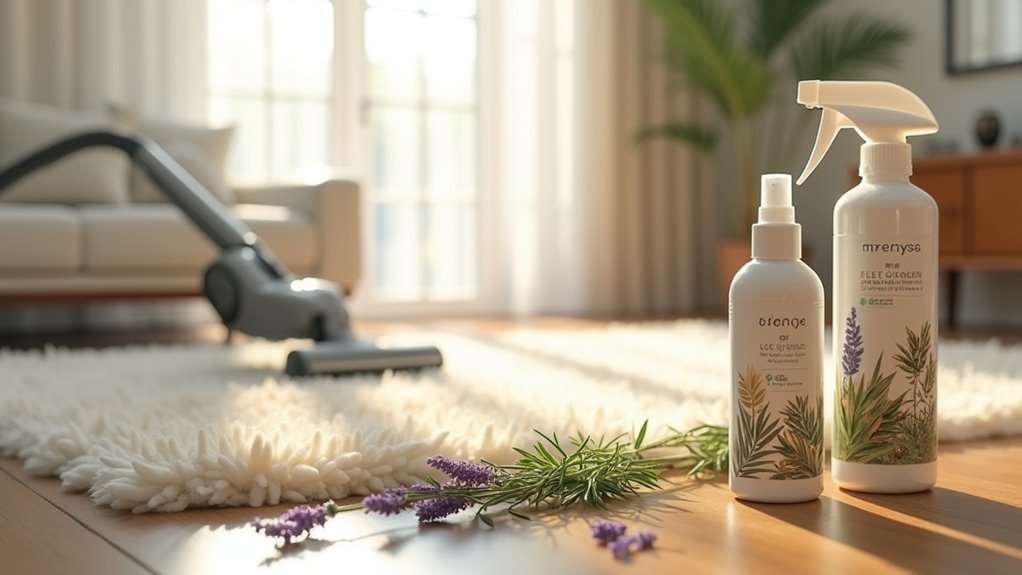
When dealing with a flea infestation, your vacuum cleaner becomes your most powerful weapon in breaking the pest’s life cycle. Deep cleaning through thorough vacuuming eliminates adult fleas, larvae, and flea eggs from carpets, sofas, and pet beds.
You’ll need to vacuum these areas regularly to disrupt the reproduction cycle effectively.
After each vacuuming session, immediately empty the dirt reservoir or dispose of vacuum bags in an outside trash can. This prevents re-infestation from any surviving pests inside your vacuum.
Supplement your vacuuming routine with steam cleaning carpets, area rugs, and upholstered furniture. The high temperatures kill fleas and their eggs naturally.
Steam cleaning uses high heat to naturally eliminate fleas and eggs from carpets, rugs, and furniture without chemicals.
Additionally, wash all pet bedding in hot water frequently. These consistent cleaning practices greatly reduce flea infestations without harmful chemicals.
Diatomaceous Earth Application
Beyond mechanical cleaning methods, diatomaceous earth offers a powerful natural solution that targets fleas through dehydration. This fossilized powder works by using its abrasive properties to kill fleas within four hours of contact, making it one of the most effective natural remedies available.
To tackle your flea infestation properly, you’ll need to apply diatomaceous earth strategically:
- Sprinkle liberally on carpets, pet bedding, and cracks where fleas hide
- Cover both indoor and outdoor infested areas thoroughly
- Leave undisturbed for at least 24 hours before vacuuming
While DE is safe for pets and humans, avoid inhaling the powder as it can irritate your lungs.
This natural approach provides fast results while maintaining an eco-friendly environment.
Vinegar Solutions for Flea Repellent
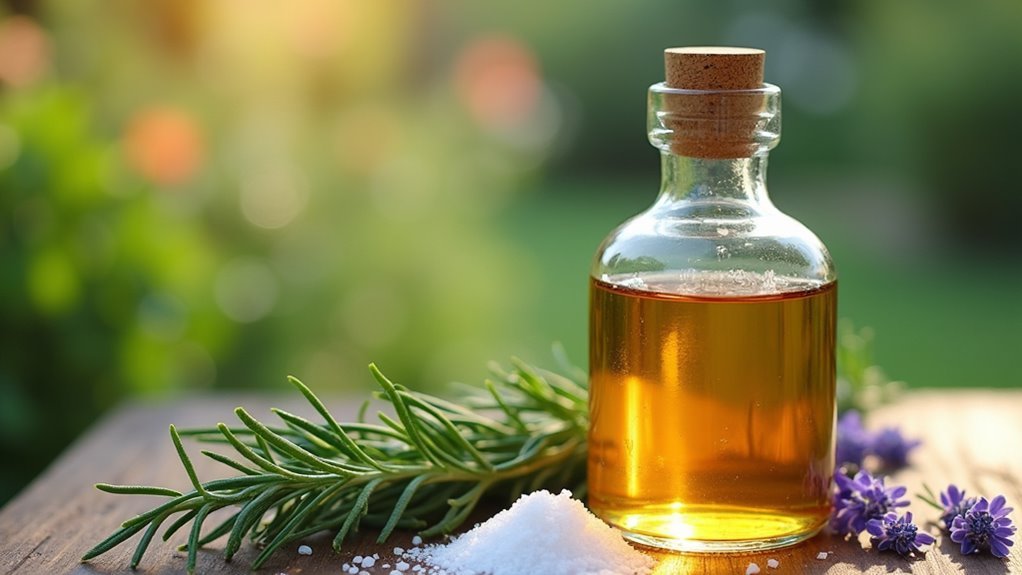
You’ll find that vinegar serves as an excellent natural flea repellent that’s both safe and affordable for your home.
Creating an effective vinegar spray requires mixing equal parts water and vinegar in a spray bottle for easy application on carpets, pet bedding, and other flea-prone areas.
This simple solution works because fleas can’t stand vinegar’s strong smell and taste, making it an ideal eco-friendly alternative to chemical treatments.
Vinegar Spray Preparation
Although commercial flea treatments flood the market with harsh chemicals, you can create an equally effective repellent using simple household vinegar. This vinegar spray serves as a natural alternative that’ll help you control fleas without compromising your family’s health.
Creating your flea-repelling solution requires minimal effort and ingredients. Simply combine equal parts distilled white vinegar or apple cider vinegar with water in a spray bottle. This cost-effective mixture targets fleas’ aversion to vinegar’s distinct taste and smell.
For ideal application:
- Spray the solution directly onto carpets, furniture, and pet bedding
- Use a cloth to wipe down treated surfaces thoroughly
- Apply regularly to maintain effectiveness
This eco-friendly approach promotes a healthier home environment while delivering reliable flea deterrent results.
Application and Effectiveness
When applying your vinegar solution effectively, target high-traffic areas where fleas congregate most frequently.
Spray pet bedding, carpets, furniture crevices, and baseboards where flea eggs and larvae typically develop. The acidic nature of vinegar solutions disrupts fleas’ life cycle, making this one of the most reliable eco-friendly ways for thorough flea prevention.
You’ll notice results within days as fleas avoid treated surfaces due to vinegar’s strong odor and taste. For maximum effectiveness, reapply every 2-3 days until the infestation clears.
Focus on areas your pets frequent most, as these spots harbor the highest concentrations of eggs and larvae.
Test small areas first to verify no staining occurs on delicate fabrics.
Consistency is key—regular application prevents re-infestation more effectively than sporadic treatments.
Salt and Baking Soda Treatment
Two common household ingredients can effectively eliminate fleas without exposing your family to harsh chemicals.
Salt and baking soda both work as desiccants, dehydrating flea eggs and adult fleas when sprinkled liberally throughout infested areas. This natural remedy provides safe flea control that’s perfect for homes with pets and children.
To maximize effectiveness:
- Sprinkle salt or baking soda generously on carpets and upholstered furniture
- Leave the treatment undisturbed for at least 24 hours
- Vacuum thoroughly to remove the powder along with dead fleas and eggs
You’ll find cleanup remarkably simple since both substances vacuum easily without leaving harmful residues.
This non-toxic approach offers an affordable alternative to commercial pesticides while delivering reliable results against flea infestations.
Essential Oil Sprays and Diffusers

You’ll find essential oils like lavender, rosemary, and cedarwood work as powerful natural flea repellents when you select safe options for your pets.
Creating effective sprays requires proper dilution—mix 10-15 drops of essential oil with 2 cups of water to guarantee both safety and potency.
You can apply these solutions directly to affected areas or use diffusers to create a continuous flea-repelling environment throughout your home.
Safe Oil Selection
How can essential oils become powerful allies in your fight against fleas while keeping your family and pets safe?
Safe oil selection is vital when choosing natural flea remedies, as not all essential oils are pet-friendly. You’ll want to prioritize oils that effectively repel fleas without harming your furry companions.
Consider these safe options for your flea control arsenal:
- Rosemary and lavender – Generally safe for most pets when properly diluted
- Peppermint and cedarwood – Effective flea deterrents with minimal toxicity concerns
- Avoid tea tree and eucalyptus – These can be toxic to cats and some dogs
Always consult your veterinarian before introducing new essential oils around pets.
Start with lower concentrations and monitor your animals for any adverse reactions to guarantee their safety.
Proper Dilution Methods
While essential oils can effectively combat fleas, improper dilution transforms these natural remedies from helpful allies into potential hazards for your household.
For flea-repellent sprays, you’ll want to mix 1-2 teaspoons of essential oils like lavender or peppermint with 1 cup of water. This proper dilution creates safe, environmentally friendly pest control solutions.
When using diffusers, add 3-5 drops of essential oil per 100 ml of water to avoid overwhelming scents.
Citrus-based flea repellents work well too—combine 1/4 cup lemon juice with 2 cups of water for effective results.
Always conduct patch tests before broader application to prevent surface irritation.
Application Techniques
Two primary application methods maximize essential oil effectiveness against fleas: targeted spraying and atmospheric diffusion.
For direct treatment, mix rosemary, lavender, or cedarwood with water in a spray bottle using proper dilution ratios. Apply this natural solution to pet bedding, carpets, and furniture where fleas commonly hide.
For whole-home coverage, use a diffuser with peppermint or lemongrass oils to disperse flea-repelling scents throughout your space. This method creates a pleasant aroma while naturally deterring fleas.
Essential safety steps include:
- Performing patch tests on surfaces before full application
- Consulting your veterinarian about oil safety for your specific pets
- Maintaining proper dilution ratios for effectiveness and safety
These application techniques guarantee you’re using essential oils safely and effectively around your pets.
Dish Soap Flea Traps
Because fleas jump toward light sources and become trapped when they can’t escape soapy water, dish soap flea traps offer one of the simplest and most cost-effective solutions for tackling adult flea populations in your home. You’ll need just warm water and 1/4 cup of dish soap mixed in a bowl. The soap breaks surface tension, causing fleas to drown immediately upon landing.
| Setup Component | Instructions |
|---|---|
| Placement | Position near infested areas at night when fleas are most active |
| Maintenance | Change water and soap mixture regularly to prevent contamination |
| Integration | Use alongside other methods since trapping only targets adult fleas, not eggs or larvae |
This eco-friendly approach provides an accessible alternative to chemical treatments while effectively reducing visible flea activity.
Citrus-Based Natural Sprays
Fresh citrus peels you’d normally throw away contain natural compounds that effectively repel fleas while filling your home with a pleasant, clean scent.
Citrus-based natural sprays offer an excellent non-toxic solution for flea control that’s safe around children and pets.
Create your own spray by mixing 1/4 cup fresh lemon juice with 2 cups water. This environmentally friendly mixture works because fleas find citrus scents repulsive and avoid treated areas.
Application tips:
- Spray pet bedding, carpets, and areas where fleas typically hide
- Avoid direct application on cats due to potential sensitivities
- Reapply regularly to maintain effectiveness
You’ll find that combining citrus sprays with thorough cleaning practices creates a powerful, chemical-free approach to managing flea infestations throughout your home.
Beneficial Nematodes for Yard Control
You can harness nature’s own pest control system by introducing beneficial nematodes to your yard.
These microscopic worms actively hunt and destroy flea larvae, offering a chemical-free solution that won’t harm your family or pets.
Understanding what nematodes are and how to apply them effectively will help you achieve dramatic results in eliminating outdoor flea populations.
What Are Nematodes
Microscopic warriors lurk in your soil, ready to wage war against fleas without harming your family or pets. Nematodes are beneficial soil-dwelling worms that naturally hunt down flea larvae, eggs, and other garden pests.
These tiny predators offer an eco-friendly solution for pest management that won’t endanger your household.
You’ll love how these microscopic allies work around the clock to eliminate flea populations naturally:
- Safe for everyone – Harmless to humans, pets, and beneficial insects
- Lightning-fast results – Reduce flea populations considerably within 24 hours
- Affordable protection – Available online or at garden centers as an economical solution
These natural pest controllers thrive in moist conditions, so water your yard before and after application.
Nematodes provide sustainable, chemical-free flea control that protects both your family and environment.
Application and Effectiveness
Three simple steps will get beneficial nematodes working in your yard to eliminate fleas naturally.
First, purchase nematodes online or at garden supply stores and apply them to moist soil conditions.
Second, time your application during early morning or late evening hours to protect these microscopic worms from harmful direct sunlight.
Third, water the treated area lightly to help nematodes penetrate soil and locate flea larvae.
You’ll see results within 24 hours as nematodes target and feed on flea larvae and pupae.
This eco-friendly solution poses no health risks to your family or pets while effectively reducing flea populations.
Cedar Wood Chips and Natural Barriers
When you’re looking for a natural and sustainable approach to flea control, cedar wood chips offer an excellent solution that’s both effective and environmentally responsible.
Cedar chips create a natural barrier around your property while releasing oils that repel fleas and kill their larvae. You’ll find this method particularly effective because it’s completely safe for pets and plants.
To maximize cedar’s flea control benefits:
- Apply chips around your property’s perimeter to create a protective zone
- Combine with other natural methods like beneficial nematodes for enhanced results
- Refresh chips regularly to maintain their pest-repelling potency
Cedar wood chips don’t just target fleas—they’ll also deter ticks and mosquitoes while adding pleasant aroma to your outdoor spaces.
Regular Pet Grooming and Bathing
While cedar chips protect your property’s perimeter, one of your most powerful weapons against fleas lies much closer to home—your pet’s regular grooming routine.
You’ll catch flea problems early through consistent brushing and combing, reducing your need for harsh chemicals later.
Weekly baths using natural soaps or organic shampoos effectively remove fleas and their eggs from your pet’s coat.
You can boost these treatments by adding properly diluted essential oils like rosemary or lavender, which naturally repel fleas while keeping your pet safe.
Establishing this routine strengthens your bond with your pet while maintaining effective flea control.
You’ll find that consistent grooming and bathing schedules dramatically reduce infestation risks, making chemical treatments unnecessary in most cases.
Frequently Asked Questions
What’s the Best Natural Remedy to Kill Fleas?
You’ll find diatomaceous earth most effective for killing fleas naturally. It dehydrates them on contact while remaining safe for pets and humans. Simply sprinkle food-grade diatomaceous earth where fleas are active and vacuum regularly.
How Do You Kill Fleas in the Environment?
You’ll kill environmental fleas by vacuuming carpets and furniture regularly, sprinkling diatomaceous earth in infested areas, maintaining clean yards through frequent mowing, and using salt mixtures to dehydrate eggs effectively.
What Kills 100% of Fleas?
You can’t achieve 100% flea elimination with a single method. However, you’ll get closest by combining regular vacuuming, washing pet bedding in hot water, and steam cleaning carpets consistently together.
Can You Get Rid of Fleas Without Chemicals?
You can eliminate fleas without chemicals using diatomaceous earth, salt, baking soda, vinegar solutions, and essential oils like lavender. Regular vacuuming and washing pet bedding in hot water also effectively reduces flea populations naturally.
In Summary
You’ve now got nine powerful eco-friendly methods to tackle your flea problem without harsh chemicals. Start with deep cleaning and vacuuming, then choose the treatments that work best for your situation. Remember, consistency is key – you’ll need to repeat these methods regularly for maximum effectiveness. By combining indoor treatments like diatomaceous earth and essential oils with outdoor solutions like beneficial nematodes, you’ll create a thorough, natural defense against fleas.

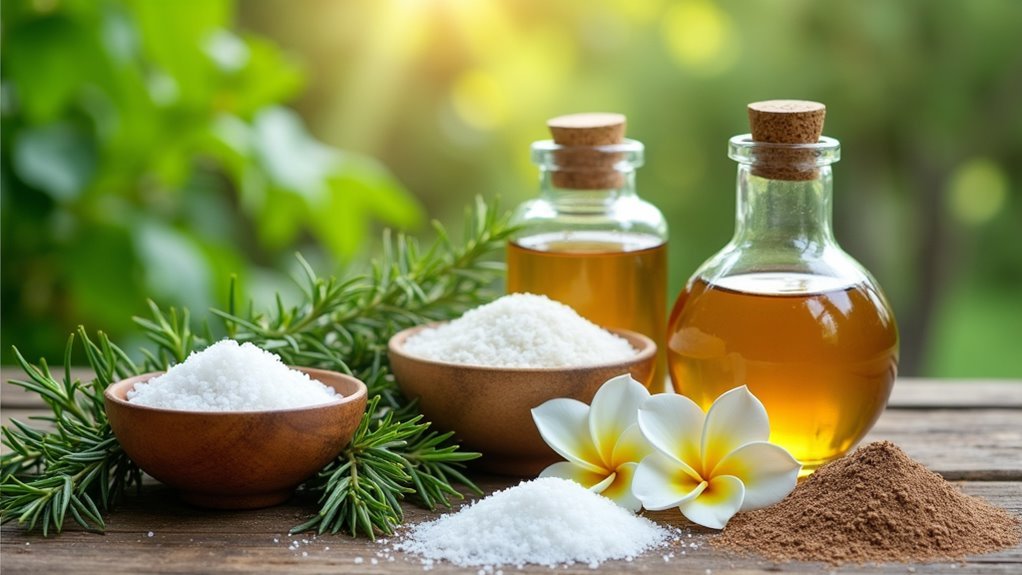

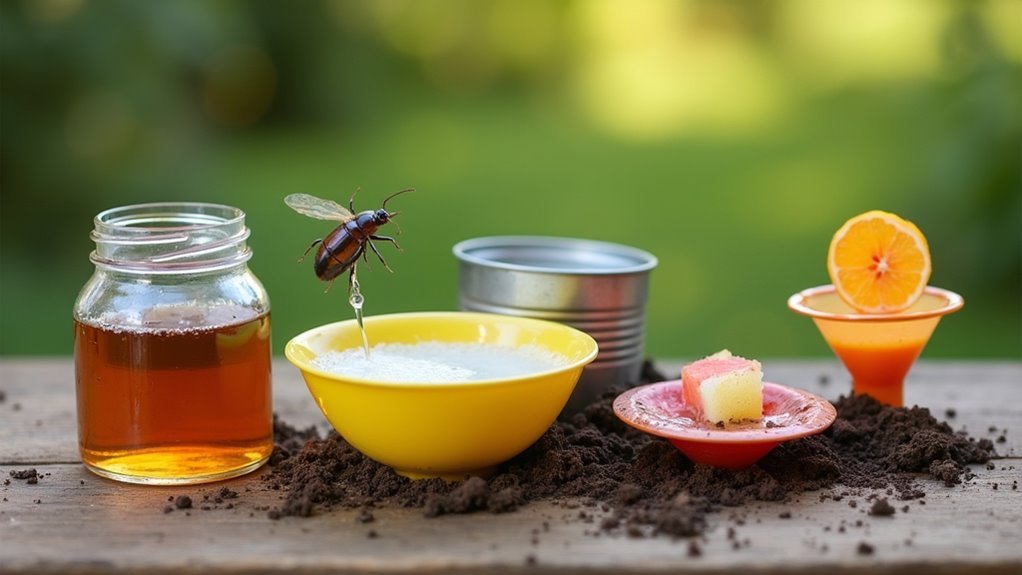
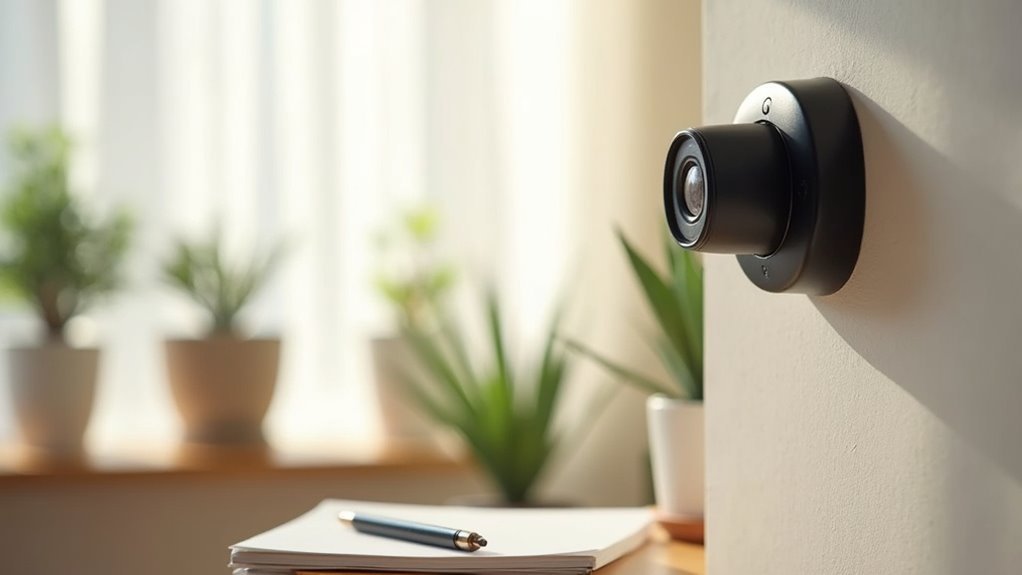
Leave a Reply